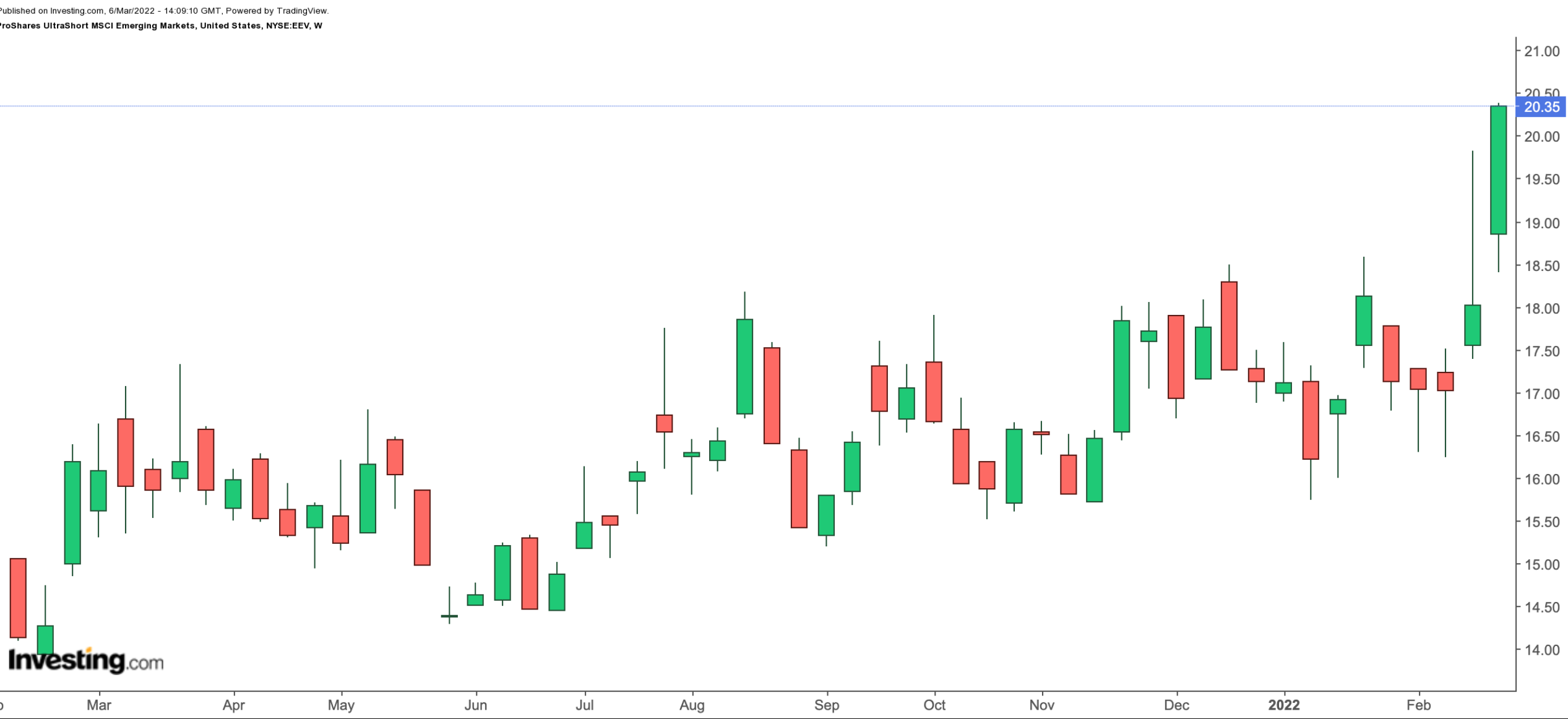Gold prices dip as December rate cut bets wane; economic data in focus
Inverse exchange-traded funds (ETFs) are getting increased attention as market worries escalate. Russia’s invasion of Ukraine has fired up already jittery risk sentiment, pushing major indices even lower. Since the start of the year, the S&P 500 and NASDAQ 100 have lost 9.0% and 15.2%.
Recent research by Colby J. Pessina and Robert E. Whaley of Vanderbilt University highlights:
"The main attraction of geared levered and inverse funds is that they offer an inexpensive, convenient, limited-liability means for profiting from a directional price view."
The authors, however, also point out:
"The problem with these products is that they are not generally well understood… They are unstable and exist only as a mechanism for placing short-term directional bets."
Regular readers would know that we frequently cover inverse ETFs, which use derivative products to provide short exposure to daily returns of various indices, sectors, or asset classes. Today’s article introduces two more such funds that might appeal to experienced short-term traders that make directional bets.
However, we should once again remind readers that these products are typically not appropriate for most retail investors.
1. ProShares UltraShort MSCI Emerging Markets
- Current Price: $20.35
- 52 Week Range: $14.29 - $20.39
- Expense Ratio: 0.95%
The ProShares UltraShort MSCI Emerging Markets (NYSE:EEV) seeks daily investment results that replicate two times the inverse performance (or -2x) of the MSCI Emerging Markets Index. In other words, it is both an inverse and a leveraged fund. EEV could appeal to traders who want to profit from daily declines in emerging markets (EMs).

The MSCI Emerging Markets Index includes 1,420 EM companies. Chinese companies account for almost a third of the index, followed by Taiwan (16.09%), South Korea (12.81%), and India (12.45%).
Military developments in Eastern Europe have put the focus on EMs. Readers might be interested to know that last week, MSCI, the New York City-based provider of an array of global financial instruments and indices, said it would be taking Russia out of EM indices.
EEV started trading in October 2007, and has $8.4 million in net assets. The leading companies in the index include Taiwan Semiconductor Manufacturing (NYSE:TSM), Tencent (HK:0700) (OTC:TCEHY), Samsung (OTC:SSNLF), Alibaba (NYSE:BABA) and Infosys (NYSE:INFY).
EEV could be an effective one-day bet against the MSCI Emerging Markets index. However, due to the compounding of daily returns, holding periods longer than one day can easily result in returns that are substantially different than the objective.
Year-to-date, EEV is up almost 18.7% in 2022. It also returned 26.4% over the past year.
By comparison, the iShares MSCI Emerging Markets ETF (NYSE:EEM) which tracks the MSCI Emerging Markets Index declined 8.6% this year and 17.1% in the past 12 months.
2. ProShares UltraShort Consumer Goods
- Current Price: $13.64
- 52-Week Range: $10.41 - $20.12
- Expense Ratio: 0.95% per year
Our second fund, the ProShares UltraShort Consumer Goods ETF (NYSE:SZK), provides daily investment results replicating two times the inverse (or -2x) exposure of the Dow Jones U.S. Consumer Goods Index. The index measures the stock performance of 108 consumer goods companies stateside.

Food, Beverage & Tobacco companies lead the index with 32.18%; next in line are Automobiles & Components (30.17%), Household & Personal Products (16.96%), and Consumer Durables & Apparel (15.27%) names.
Among the leading stocks in the index are Tesla (NASDAQ:TSLA), Procter & Gamble (NYSE:PG), Coca-Cola (NNYSE:KO), Nike (NYSE:NKE), Mondelez International (NASDAQ:MDLZ) and General Motors (NYSE:GM).
SZK aims to profit from a market decline in these consumer goods companies while extending the short-term outlook with a daily 2x leverage. The fund was listed in January 2007, and net assets stand at almost $1 million.
So far in the year, SZK is up about 21.6%. However, over the past 12 months, the inverse fund has declined almost 30%.
Meanwhile, the Dow Jones U.S. Consumer Goods Index is down 13.5% in 2022, and 2.2% in the past year. Economists have been paying close attention to the mood of the US consumer. Economic and geopolitical concerns as well as supply chain issues have been overshadowing the more positive development regarding the declining number of COVID-19 cases.
Therefore, short-term traders who expect US consumer shares to come under further pressure could use this inverse leveraged fund as a daily trading tool. However, they need to appreciate that it is not appropriate as a long-term investment.
